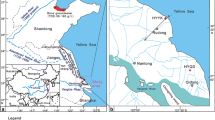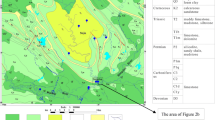Abstract
Elements in lake sediments and lake water were commonly used in the reconstruction for the paleoenvironment and paleoclimate, and also enriched into mineral deposit, such as lithium deposit. However, previous studies seldom distinguish the elements in porewater and minerals, and also seldom considered water–sediment interaction and how the elements of different properties migrated and enriched during the drying climate. This study investigated the major and trace elements of the porewater, and the carbonate and silicate minerals in a 407–cm-long core from Guozha Co, a brackish lake on the northwestern Tibetan Plateau. Our results indicated that (a) Ca and Sr were predominantly present in carbonate minerals, while Na, K, Mg, Li, were primarily preserved in silicate minerals. (b) the elements of porewater were closed with those of silicate minerals; (c) Nawater, Naacid, Liwater, and Liacid were more sensitive to drying climate than the others; (d) Identifying Mg/Ca, Sr/Ca and Li/Ca sources is better, rather than directly using the whole sample data to discuss environmental changes. (e) Mgwater/Liwater were much lower than those of Mgacid/Liacid and Mgresidue/Liresidue. Low temperature favors the movement of Li in aqueous solution and carbonate minerals. This is useful for the lithium extraction from brines.








Similar content being viewed by others
Data availability
The original contributions presented in the study are included in the article/Supplementary Material. Further inquiries can be directed to the corresponding author.
References
Andrews E, Pogge von Strandmann PAE, Fantle MS (2020) Exploring the importance of authigenic clay formation in the global Li cycle. Geochim Cosmochim Acta 289:47–68
Berner (1980) Early diagenesis: a theoretical approach. Princeton Press, Princeton
Brown GE Jr (2001) How minerals react with water. Science. https://doi.org/10.1126/science.1063544
Bureau of Geology and Mineral resources of Xizang Autonomous Regions (1993) Regional Geology of Xingzang (Tibet) Autonomous Region. Geological Publishing House, Beijing (in Chinese)
Chen H, Zhu LP, Ju JT, Wang JB, Ma QF (2019) Temporal variability of 14C reservoir effects and sedimentological chronology analysis in lake sediments from Chibuzhang Co, North Tibet (China). Quat Geochronol 52:88–102
Dellinger M, Bouchez J, Gaillardet J, Faure L, Moureau J (2017) Tracing weathering regimes using the lithium isotope composition of detrital sediments. Geology 45:411–414
Elderfield H, Ferretti P, Greaves M, Crowhurst S, McCave IN, Hodell D, Piotrowski AM (2012) Evolution of ocean temperature and ice volume through the Mid-Pleistocene climate transition. Science 337(704):704–709
Gorski CA, Fantle MS (2017) Stable mineral recrystallization in low temperature aqueous systems: a critical review. Geochim Cosmochim Acta 198:439–465
Guo XY (2021) Restrictive factors of lithium in clay minerals. A Dissertation Submitted to China University of Geosciences for Master of Professional Degree (in Chinese with English Abstract)
Gyawali AR, Wang JB, Ma QF, Wang Y, Xu T, Guo Y, Zhu LP (2019) Paleo-environmental change since the Late Glacial inferred from lacustrine sediment in Selin Co, central Tibet. Palaeogeogr Palaeoclimatol Palaeoecol 516:101–112
Huh Y, Chan LC, Edmond JM (2001) Lithium isotopes as a probe of weathering processes: Orinoco River. Earth Planet Sci Lett 194:189–199
JimÈnez-López C, Caballero E, Huertas FJ, Romanek CS (2001) Chemical, mineralogical and isotope behavior, and phase transformation during the precipitation of calcium carbonate minerals from intermediate ionic solution at 25 ℃. Geochim Cosmochim Acta 65(19):3219–3231
Kesler SE, Gruber PW, Medina PA, Keoleian GA, Everson MP, Wallington TJ (2012) Global lithium resources: relative importance of pegmatite, brine and other deposits. Ore Geol Rev 48:55–69
Lear CH, Rosenthal Y (2006) Benthic foraminiferal Li/Ca: insights into Cenozoic seawater carbonate saturation state. Geology 34:985–988
Li BY, Zhang QS, Wang FB (1991) Evolution of the lakes in the Karakorum-West Kunlun mountains. Quat Sci 1:64–71 (in Chinese with English abstract)
Li MH, Kang SC, Zhu LP, You QL, Zhang QG, Wang JB (2008) Mineralogy and geochemistry of the Holocene lacustrine sediments in Nam Co. Tibet Quat Int 187:105–116
Li MH, Kang SC, Zhu LP, Wang JB, Zhang QG, Xie MP, You QL (2009) On the unusual holocene carbonate sediment and environmental change in Nam Co (Lake), Central Tibet. J Mountain Sci 6:346–353
Li CG, Wang MD, Liu WG, Lee SY, Chen FH, Hou JZ (2021a) Quantitative estimates of Holocene glacier meltwater variations on the Western Tibetan Plateau. Earth Planet Sci Lett 559:116766
Li MH, Zhu LP, Wang JB, Ju JT, Liu C, Ma QF, Xu T, Qiao BJ, Wang XX (2021b) Holocene lake evolution and glacial fluctuations indicated by carbonate minerals and their isotopic compositions in the sediments of a glacial melt recharge lake on the northwestern Tibetan Plateau. Front Earth Sci 9:656281
Li MH, Fang XM, Wang ZR, Li J, Yan MD, Galy A, Wang JY, Lu SY, Zhu LP (2022) Using mineralogy and Sr-Nd isotopes of gypsum to constrain the provenance of sediments in the western Qaidam Basin, northern Tibetan Plateau: implications for neo-tectonic activities. J Asian Earth Sci 223:104983
Li MH, Wang XX, Zhu LP, Li J, Fang XM (2023) Minerals, elements and environmental factors affecting the migration and enrichment of lithium in Qinghai-Tibet Plateau Lakes: a case study of sediments in Guozha Co Borehole. Chin J Inorg Anal Chem 13(7):716–724 (In Chinese with English Abstract, doi:10.3969/j.issn.2095-1035.2023.07.007)
Liu LF, Zhang HW, Zhang YS, Cao DM, Zhao SH (2015) Lithium extraction from seawater by manganese oxide ion sieve MnO2·5H2O. Colloids Surf A Physicochem Eng Aspects 468:280–284
Marriott CS, Henderson GM, Crompton R, Staubwasser M, Shaw S (2004) Effect of mineralogy, salinity, and temperature on Li/Ca and Li isotope composition of calcium carbonate. Chem Geol 212:5–15
Nie Z, Wu Q, Bu L (2017) Exploitation of carbonate lithium salt lake in Qinghai-Tibet Plateau, China. Sci Technol Rev 35(12):49–54 (in Chinese with English abstract)
Putnis CV, Ruiz-Agudo E (2013) The mineral–water interface: where minerals react with the environment. Elements 9:177–182
Qiao BJ, Zhu LP (2019) Difference and cause analysis of water storage changes for glacier-fed and non-glacier-fed lakes on the Tibetan Plateau. Sci Total Environment 693:133399
Qiao BJ, Zhu LP, Wang JB, Ju JT, Ma QF, Liu C (2017) Estimation of lakes water storage and their changes on the northwestern Tibetan Plateau based on bathymetric and Landsat data and driving force analyses. Quatern Int 454:56–67
Rivadeneyra MA, Párraga J, Delgado R, Ramos-Cormenzana A, Delgado G (2004) Biomineralization of carbonates by Halobacillus trueperi in solid and liquid media with different salinities. FEMS Microbiol Ecol 48:39–46
Shannon RD (1976) Revised effective ionic radii and systematic studies of interatomic distances in halides and chalcogenides. Acta Crystallogr A A32(5):751–767
Swart PK (2015) The geochemistry of carbonate diagenesis: the past, present and future. Sedimentology 62:1233–1304
Tomonaga Y, Brennwald MS, Livingstone DM, Brennwald MS, Livingstone DM, Kwiecien O, Randlett M, Stockhecke M, Unwin K, Anselmetti FS, Beer J, Haug GH, Schubert CJ, Sturm M, Kipfer R (2017) Porewater salinity reveals past lake-level changes in Lake Van, the Earth’s largest soda lake. Sci Rep 7:313
Wallmann K, Aloisi G, Haeckel M, Tishchenko P, Pavlova G, Greinert J, Kutterolf S, Eisenhauer A (2008) Silicate weathering in anoxic marine sediments. Geochim Cosmochim Acta 72:3067–3090
Wang XX (2021) Genetic mineralogy of Carbonates and Environmental events in borehole Sediments from Guozha Co, Tibet. A thesis submitted to University of Chinese Academy of Sciences (in Chinese with English abstract)
Zhang Y, Wang L, Sun W, Hu YH, Tang HH (2020) Membrane technologies for Li+/Mg2+ separation from salt-lake brines and seawater: a comprehensive review. J Ind Eng Chem 81:7–23
Zhu GH, Ma J, Wei G, Zhang L, Wang Z, Zhang Z, Zeng T (2023) Lithium isotope fractionation during the weathering of granite: Responses to pH. Geochim Cosmochim Acta 345:117–129
Acknowledgements
This study was supported by the Key Project of National Natural Science Foundation of China (41831177), China Ministry of Science and Technology the Second Tibetan Plateau Scientific Expedition and Research (2019QZKK0202), the Strategic Priority Research Program of Chinese Academy of Sciences (Grant No. XDA20020100, XDA20070101).
Author information
Authors and Affiliations
Contributions
Minghui LI: Methodology, Investigation, Data curation, Writing – original draft, Liping Zhu: Writing – review & editing, Validation, Supervision, Project administration, Funding acquisition. Junbo Wang: Investigation, Field work; Samples administration; Jianting Ju: Investigation, Field work; Xiaoxiao Wang: Methodology, Data curation; Chong Liu: Investigation, Field work; Qingfeng Ma: Investigation, Field work; Teng Xu, Investigation, Field work; Baojin Qiao, Investigation, Field work.
Corresponding author
Ethics declarations
Competing interests
The authors declare no competing interests.
Conflict of interest
The authors declare that they have no known financial interests or personal relationships that could have appeared to influence the work reported in this paper.
Additional information
Publisher's Note
Springer Nature remains neutral with regard to jurisdictional claims in published maps and institutional affiliations.
Supplementary Information
Below is the link to the electronic supplementary material.
Rights and permissions
Springer Nature or its licensor (e.g. a society or other partner) holds exclusive rights to this article under a publishing agreement with the author(s) or other rightsholder(s); author self-archiving of the accepted manuscript version of this article is solely governed by the terms of such publishing agreement and applicable law.
About this article
Cite this article
Li, M., Zhu, L., Wang, J. et al. Elemental interactions between pore water and lake sediments with their environmental significance: a case as Holocene sediments in Guozha Co, northwestern Tibetan Plateau. Environ Earth Sci 83, 111 (2024). https://doi.org/10.1007/s12665-024-11429-0
Received:
Accepted:
Published:
DOI: https://doi.org/10.1007/s12665-024-11429-0




